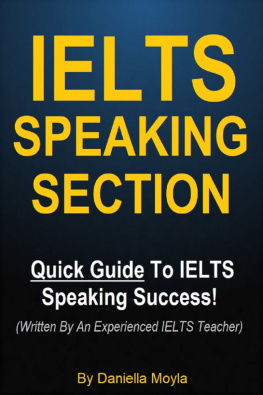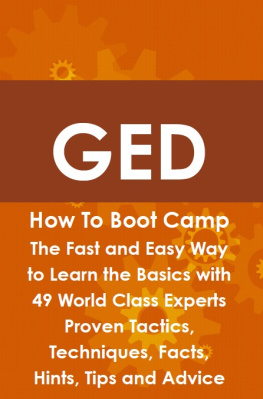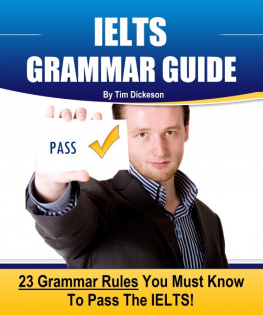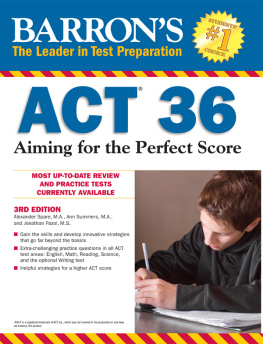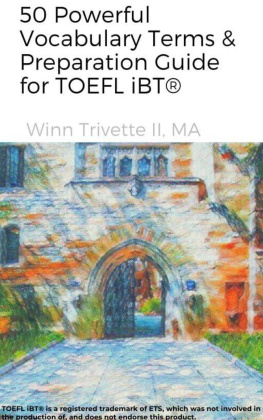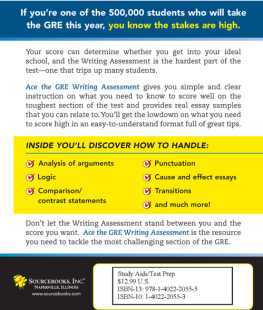Randall McCutcheon - Increase Your Score in 3 Minutes a Day
Here you can read online Randall McCutcheon - Increase Your Score in 3 Minutes a Day full text of the book (entire story) in english for free. Download pdf and epub, get meaning, cover and reviews about this ebook. year: 2004, publisher: McGraw-Hill Education, genre: Children. Description of the work, (preface) as well as reviews are available. Best literature library LitArk.com created for fans of good reading and offers a wide selection of genres:
Romance novel
Science fiction
Adventure
Detective
Science
History
Home and family
Prose
Art
Politics
Computer
Non-fiction
Religion
Business
Children
Humor
Choose a favorite category and find really read worthwhile books. Enjoy immersion in the world of imagination, feel the emotions of the characters or learn something new for yourself, make an fascinating discovery.

- Book:Increase Your Score in 3 Minutes a Day
- Author:
- Publisher:McGraw-Hill Education
- Genre:
- Year:2004
- Rating:5 / 5
- Favourites:Add to favourites
- Your mark:
- 100
- 1
- 2
- 3
- 4
- 5
Increase Your Score in 3 Minutes a Day: summary, description and annotation
We offer to read an annotation, description, summary or preface (depends on what the author of the book "Increase Your Score in 3 Minutes a Day" wrote himself). If you haven't found the necessary information about the book — write in the comments, we will try to find it.
This accessible guide gives you the tools you need to score high on the new SAT essay.
Increase Your Score in 3 Minutes a Day — read online for free the complete book (whole text) full work
Below is the text of the book, divided by pages. System saving the place of the last page read, allows you to conveniently read the book "Increase Your Score in 3 Minutes a Day" online for free, without having to search again every time where you left off. Put a bookmark, and you can go to the page where you finished reading at any time.
Font size:
Interval:
Bookmark:
Also in this series
Increase Your Score in 3 Minutes a Day: SAT Critical Reading, McCutcheon and Schaffer

For my grandmother
Randall McCutcheon
To Mary Lynn, for her unwavering love
and support, and to Suzanne, Sarah, and
Stephen, who make it all worthwhile.
James Schaffer
Memoirs of a Grammarian
Professional writers know a secret. Ill tell it to you right now so you can skip years of ineffective writing and get directly to the effective stuff. Here goes:
Context is everything.
I know it doesnt sound like much, but youd be surprised how few people, even very literate people, understand it. That beautiful passage you think about so often? Probably it isnt beautiful because of the writers choice of words so much as because it draws together, and draws upon, the material that comes before it. Writing effectively isnt all that much different from telling a good joke. Rambling along during the setup only makes the punch line less punchy.
Heres another thing about context: the way you write depends on what youre writing. Advertising copy doesnt read like a novel. A novel doesnt read like a corporate reportor at least a good one doesnt.
Im sure that right now the SAT essay makes the short list of threatening and unavoidable ordeals looming in your immediate future. Fortunately you are holding in your hand a book that, while it may not succeed in making the essay any more avoidable, can certainly make it less threatening. It is filled with reliable advice about keeping your essay on track, ensuring that things go well together, and choosing an approach suited to the task youre undertakingin short, about being mindful of context. That, after all, is the key to effective writing.
And remember this: no matter how bleak things look, youll still have it better than I did. I needed nine years and two discarded 750-page drafts to write Memoirs of a Geisha. Your struggle, on the other hand, will draw to a close no more than a few hours after it begins. Sigh.
Anyway, its a good thing you have this wise and useful book to help you with it. So what are you waiting for? Youve got some reading to do.
Arthur Golden, author of
Memoirs of a Geisha
The authors would like to thank the following people: Jane Durso, Peter Durso, Elizabeth Durso, Nick Durso, Matthew Barrett, Amaris Singer, Ladan Jafari, Molly Dunn, Yasmin Mashhoon, Reah Johnson, Austan Goolsbee, Jeremy Mallory, Christopher Brown, Mary Schafer, Thomas Schaffer, Devin Bethune, Cynthia Brazda, Ashley Buck, Melissa Casper, Valerie Cobb, Gordon Coffin, Brandon Fisher, Bobbi Kracl, Dustin Lottman, Melissa McCall, Ryan Shaw, Tatum Thies
You know, the SAT dropping the analogy portion
of the test is like Yogi Bear dropping, uh, uh,
something very relatable to a similar thing.
Dennis Miller
As comedian Dennis Miller reminds us, the folks at the College Board have ended the analogy portion of the SAT. Critics claimed the analogies favored students with larger vocabularies and did little to measure actual reasoning ability. In a public relations ploy worthy of researchers who, according to New York Senate testimony, sit around all day playing with their psychometric navels, the College Board (which owns the test) announced that the revised SAT provides a stronger link between what students are taught in school and what they are tested on.
Question: The SAT is now a better indicator of a students academic potential because
A. The test eliminates the correlation between affluence and high scores.
B. The test encourages less formulaic writing and more original thinking.
C. Trained readers score the writing samples.
The correct answer is none of the above.
The most significant addition to the new improved SAT is the writing test. More than two million students must face this addition, this rite of passage, each year. You, for example. Is this a fair measure of your potential? Hmm As a high school student, University of Chicago professor Austan Goolsbee wrote that the SAT should have one judging criterion: It should be more than a meaningless rite. It should be educationally right.
Goolsbee was on to something. Teachers of writing must battle bravely against the Beast from the East. But how? Peggy Hill, on the animated television show King of the Hill, echoed the battle cry of most contemporary writing teachers: You do not come into my house and correct my grammar unless your name is Strunk or White.
Clearly, the classic Elements of Style is more revered than any book of its kind. And you could do far worse than worshipping this geriatric text. The book you are reading never strays far from the teachings of William Strunk Jr. and E. B. White. After all, the person who reads your essay will reward the clear and correct writing prescribed in Elements.
The truth is, lively writing comes from more than simply following the rules. White himself admitted to writing by ear. He knew that expressiveness is not always about exactness. It is more often about taking risks. O frabjous day.
In the New Yorker, Adam Lehner spoofed the advice of Strunk and White.
Blessed are the verbose in spirit, for theirs shall be the kingdom of clarity; the inheritance of the ability to name those children who sat beside them in third grade, and of the ability to name many animals, in a singular minute, is whats coming to those who use complicated grammar.
Once again truth trumps fiction. In a 1982 study, Hunter Bre-land and Robert Jones of the Educational Testing Service (ETS) found that verbosity was more important in achieving high scores than such other essay characteristics as sentence logic, supporting materials, and precision of diction. David Owen, who discusses this research in his book None of the Above, suggests that test takers should also remember to indent. Evidently, the ETS readers like lots of paragraphs, too.
Of course, much time has passed since the Breland and Jones study. Changes have been implemented. The College Board assures students that these essays will be graded by experienced high school and college English teachers. In an unprecedented experiment to prove that two wrongs can make a right, each essay will be evaluated by two readers, who then will have their scores added together to arrive at your subscore. If the two readers scores are more than one point apart, a third reader will be called in. Thorough? Yes. Expensive? Oh boy.
In a cover story for Time, reporter John Cloud concluded, The pressure to read fastand to reward competent but formulaic essayswill be massive. Jane Mallison, a reader of standardized test essays for more than twenty years, compared the scoring of the essays to judging beef stew at the county fair. She said:
Youre not grading the beef. Youre not grading the sauce. Youre not grading the herbs. Youre grading the whole stew.
This book, then, is about the stew, the whole stew, and nothing but the stew.
We didnt exaggerate. You can significantly improve your chances for a higher score on the SAT by studying this book for three minutes a day. OK, we exaggerated slightly. Conscientious students (and slow readers) may want to invest a few more minutes each day. Practice and review. Practice and review.
Next pageFont size:
Interval:
Bookmark:
Similar books «Increase Your Score in 3 Minutes a Day»
Look at similar books to Increase Your Score in 3 Minutes a Day. We have selected literature similar in name and meaning in the hope of providing readers with more options to find new, interesting, not yet read works.
Discussion, reviews of the book Increase Your Score in 3 Minutes a Day and just readers' own opinions. Leave your comments, write what you think about the work, its meaning or the main characters. Specify what exactly you liked and what you didn't like, and why you think so.




